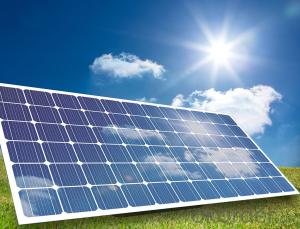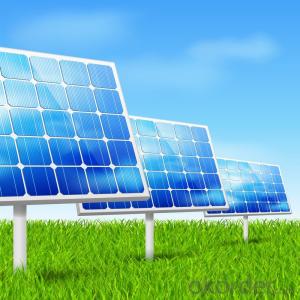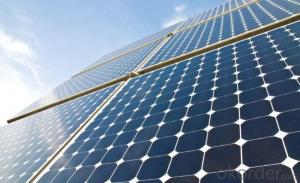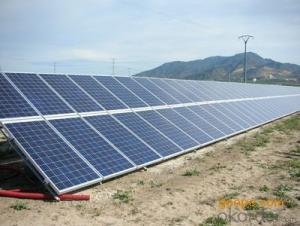230W Solar Panel Price from China, PV Solar Module Price
- Loading Port:
- Shanghai
- Payment Terms:
- TT OR LC
- Min Order Qty:
- 11 watt
- Supply Capability:
- 1111111 watt/month
OKorder Service Pledge
OKorder Financial Service
You Might Also Like
1.Structure of Solar Module Description
The solar module is an off-gird solar power generator, designed to provide stable and reliable electricity to homes and communities without access to grid electricity or to those regions where are short of power or even without power. The solar module is convenient to move, easy to set-up with reliable performance, making it ideal for situations where emergency power is required. It is an ideal & reliable energy source for a wide variety of applications, ranging from lighting , radios, fans ,televisions ,computers ,refrigerator. The USB port is compatible with all 5V-USB charged devices. It can also act as a back-up power source during emergency situations.
2.Main Features of the Solar Module
1).High conversion efficiencies resulting in superior power output performance.
2).Outstanding power output even in low light or high temperature conditions
3).Optimized design for ease of soldering and lamination
4).Long-term stability,reliability and performance
3.Solar Module Images
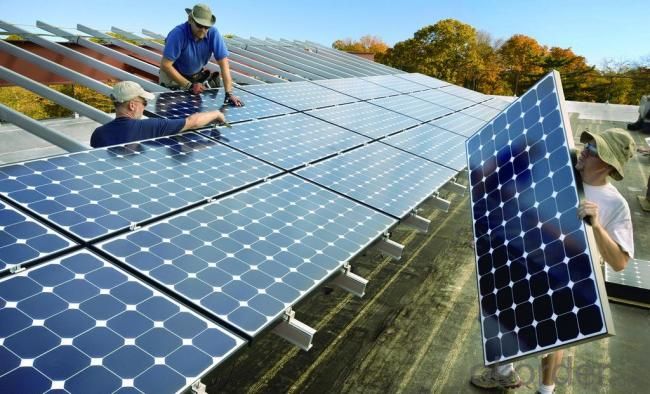

4.Solar Module Specification
Solar Panel Parameters | CNCC230W |
Optimized working voltage | 29.80V |
Optimized working current | 7.73A |
Open circuit voltage | 37.0V |
Short circuit current | 8.22A |
Nominal power | 230W |
Module efficiency | 14.08% |
Operating temperature | -40°C to+85°C |
Maximum system voltage | 1000VDC(IEC)/600VDC(UL) |
Series fuse rated value | 15A |
Power tolerance | ±3% |
Cell specification | 156×156mm (6inch) |
Arrangement quantity | 60(6×10) |
Solar panel dimension | 1650×992×45mm |
Weight | 23.0kg |
Glass specification | 3.2mm(0.13inch) tempered glass |
Frame | Anodised aluminium alloy |
Rated operating temperature | 45±2°C |
Pmax temperature parameter | -(0.48±0.05)%/°C |
Voc temperature coefficient: | -(0.34±0.1)%/°C |
Isc temperature coefficient | 0.04±0.01%/°C |
Dimension of pallet | 1700*1150*1150mm |
Quantity in a 20’ container | 14pallet; 23pcs/pallet;322pcs |
Quantity in a 40’ container | 28pallet;29pcs/pallet;644pcs |
Notic:Data under standard testing condition (STC):1000W/m2,AM1.5,25°C. | |
5.FAQ of Solar Module
1). Q: Are you a factory or trading company?
A: We are a factory.
2). Q: Where is your factory located? How can I visit there?
A: Our factory is located in Jiangyin, Jiangsu, China, near Shanghai. You are warmly welcomed to visit us!
3). Q: How can I get some samples?
A: Please connect me for samples
4). Q: Can the price be cheaper?
A: Of course, you will be offered a good discount for big amount.
- Q:I need a list of worldwide solar panel manufactures from china, US, Spain, Germany, Japan etc...Can any one direct ne to such place?I rather it will also contain comparison of parameters like efficiacy, quality etc and to be divedied by country of manufacturing.Thank you
- Actually Ofir, it is much easier and less expensive than you might believe. What you need is a magazine, like, Solar Today. There is only one that I am familiar with that gets into the nuts and bolts of solar panel manufacturers, installation, and other types of renewable energy. It's called, Home Power Magazine. We have a home that has been powered by the wind and sun for the last 0 years or so, and most of our initial information came from Home Power, and afterward, from many of the sources that they have in their articles. Every few issures, they take an item connected to renewable energy, such as an inverter, wind turbine, water turbine, or solar panel, and list all the different models that are available. They are broken down by manufacturer, and include specifications like power output, range of voltages, efficiency, materials, and even where they are manufactured. If you subscribe online for one year, the cost is around $25 USD, you will have access to all the previous issues that are archived on their website. You can use their search engine to locate an article listing all the solar panels, they did one a year or so ago with all the information you are looking for. Despite what you might be hearing, solar power usage is growing at an incredible rate. In the US alone, there are over 00,000 homes and businesses operating some level of solar power right now, that's good news. As far as different countries using different requirements, most all of the manufacturers today are selling their products to most countries worldwide, they are designed to meet requirements for almost anyplace you might use them. Check the magazine out today, you might learn more than you were originally looking for. I will include their link below, and some other good sources for information. You can google any one of them to find their website. Good luck, and take care...Rudydoo
- Q:I don't see much solar panels on people's houses where I live. I got a long time to go before doing so but I was planning on buying a few solar panels when I retire in the far future. In your opinion, is such an investment worth it? Would you buy them? I realize they are very expensive hence why I said when I retire. Thanks for your opinion
- The payback is usually between about 5 and 5 years depending on how expensive electricity is in your area, the rebates available, and where you live (is it sunny most of the time?) Most people that get them don't do it for the investment - they do it to be energy responsible - but it's not a bad way to do both if you have the money to put into it. I personally just pay for the green energy option from my electricity provider. So I am buying power from solar and wind farms, and it cost about 0% more per month. I don't get the benefit of free power, but it comes with a smaller price tag initially, and I think when we all invest in these technologies, the price will improve over time, so energy costs will be lower in the future.
- Q:I am building a solar car for the energy wiz competition and I was wondering how I could possibly get my solar panel to shift sideways
- having solar panels move like that on a mobile platform is inadvisable -- especially if there is a dynamic wind load resulting from the motion of the mobile platform. Even having a tilt mechanism is dubious at best. think of what limited marginal gain would be gained by mounting a small solar panel on the moon roof of a car. (ultimately, the best answer is to turn the car so that it's angle to the sun is optimal -- but the road/travel direction constraints are what ultimately prohibit that.) while there are ways to build sliding panels, the weight constraints would interfere with your weight/thrust ratios to the point of futility. if you really need that panel somewhere else, don't slide it out of the way, just buy another panel and mount it there. it's more expensive, but it's actually the cheapest solution in terms of design on a mobile platform.
- Q:Can solar panels be installed on forests or protected areas?
- Yes, solar panels can be installed on forests or protected areas, but it requires careful planning and consideration to minimize the impact on the environment and wildlife. The installation should be done in a way that avoids clearing large areas of trees and minimizes disturbance to the local ecosystem. By adopting best practices and consulting with experts, solar panels can be installed on forests or protected areas in a sustainable and responsible manner.
- Q:Solar panels which is the one produces the power...I wanna the complete description about it...
- If you're expecting to use them for anything other than a science fair project, don't bother. In order to produce any significant amount of power, solar panels have to be made of complex materials and coated with special coatings. If you want to power anything with them you'll need an inverter. Solar is not a DIY project (no matter how much those scam kits claim). If you're serious about solar, call your local solar installer and talk to them about it.
- Q:Are there any risks of fire associated with solar panels?
- Yes, there are some risks of fire associated with solar panels. While solar panels themselves do not combust, there have been instances where electrical malfunctions, such as faulty wiring or improper installation, have led to fires. Additionally, if a fire breaks out in the vicinity of solar panels, it can be more challenging for firefighters to extinguish due to the electric current flowing through the panels. However, when installed and maintained properly, the risks of fire are relatively low.
- Q:Its cloudy out and i have a solar panel that has 3, .5 volt cells But how do i charge it without sun any other ways?
- Just to clarify the terminology here, solar panels can be used to charge batteries. The solar panel produces electricity from the sun but you do not charge the solar panel. So I'm assuming you have 3 .5 volt rechargeable batteries connected to a solar panel in some kind of integrated unit. The batteries are probably wired in series giving you a 4.5 volt output from the unit which you can use for powering LED's, portable radio etc. The solar panel may have about 2 solar cells wired in series, each producing up to 0.5V in good sunlight, but the amount of current they produce depends on their physical size, the sun's intensity, the load being supplied, and the type of solar cells. If it has the cheaper amorphous silicon solar cells, they will actually produce some useful output on cloudy days and charge your batteries slowly. However if they are more expensive crystalline cells they will only work with good sunlight, but then they will work very well and charge your batteries relatively quickly.. If your batteries are not charging enough on a cloudy day you could connect a mains-powered 4.5V charger to the output terminals of your unit. However you may need technical expertise to make this work because of the possible presence of internal blocking diodes. You also need to ensure the mains charger has appropriate power ratings and the connection to your unit is made safely, + to + and - to - . I hope this helps.
- Q:Why would someone use a solar panel? Does it have to do with the economy right now, global warming, or what?
- solar cell is a solar cell solar panel are many solar cells.... Typically people refer to a single solar panel as a solar panel, even though they should be reffering to it as a solar cell. A solar panel is a panel of solar cells working in conjunction with each other. I hope that makes sense it is just the incorrect terminology people always use.
- Q:How much solar energy does a 2m by a 3m solar panel convert to energy on a sunny day? Assume that the solar cells are 30% efficient.I'm not looking for the answer so much as I need an explanation o how to solve this type of problem... Thanks!!
- A watt is the fee at which vigour is produced. It's analogous with horsepower, hp = 745W= 33,000 toes-lbs per minute. So the wattage of a sunlight panel is the capacity of the panel to drive a procedure like run a motor or power a radio. General energy calculations are a part of the bigger class of Physics.
- Q:What is the working principle of solar panels?
- The production of solar cells is mainly based on semiconductor materials, its working principle is the use of optoelectronic materials to absorb light energy after the photoelectricity in the conversion reaction, according to the different materials used, solar cells can be divided into:
1. Manufacturer Overview |
|
|---|---|
| Location | |
| Year Established | |
| Annual Output Value | |
| Main Markets | |
| Company Certifications | |
2. Manufacturer Certificates |
|
|---|---|
| a) Certification Name | |
| Range | |
| Reference | |
| Validity Period | |
3. Manufacturer Capability |
|
|---|---|
| a)Trade Capacity | |
| Nearest Port | |
| Export Percentage | |
| No.of Employees in Trade Department | |
| Language Spoken: | |
| b)Factory Information | |
| Factory Size: | |
| No. of Production Lines | |
| Contract Manufacturing | |
| Product Price Range | |
Send your message to us
230W Solar Panel Price from China, PV Solar Module Price
- Loading Port:
- Shanghai
- Payment Terms:
- TT OR LC
- Min Order Qty:
- 11 watt
- Supply Capability:
- 1111111 watt/month
OKorder Service Pledge
OKorder Financial Service
Similar products
New products
Hot products
Hot Searches
Related keywords
